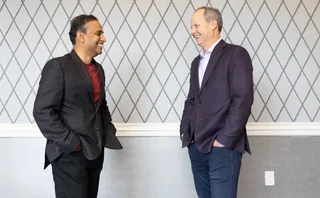Burning Issues: Could an Instant Message Be Worth a Thousand Bloomberg Terminals?

"One of the most exciting changes in market data for many years." No, I'm not talking about the fact that my esteemed editor Max Bowie has left me in charge of Inside Market Data for a fortnight as he takes a well-deserved vacation. Rather, this is one of the more colorful ways Markit's Open Federated Chat initiative was described to me this week.
If you haven't heard of it yet, Open Federated Chat is a new open messaging network that will allow financial professionals to communicate with one another regardless of their communication platform. It means that a trader using Microsoft Lync in sell-side firm A can chat to a customer using AOL Instant Messenger in buy-side firm B or indeed anyone else, sell-side, buy-side or vendor, provided their chat system is supported by Markit and they are a federated member of the network.
This week Morgan Stanley joined Goldman Sachs and Deutsche Bank as an official federated member - which essentially means the bank will hand over its entire contact directory to Markit and will be able to sponsor its buy-side clients to become federated members too. Other rumored partners include Citgroup, UBS, Credit Suisse, JP Morgan, Bank of America and Barclays; noticeably, six of the nine are founding banks of trade reporting platform Markit BOAT.
Though Markit does not refer openly to Bloomberg's Instant Messenger in its Open Federated Chat documentation - rather the vendor alludes to "closed established technology platforms and restrictive business models" - there is a general expectation (dare I say hope) in the industry that this initiative could displace Bloomberg's Instant messenger as the dominant communication tool used in financial services. Currently Bloomberg's messaging network is used by 315,000 financial and business professionals compared to the 190,000 that use Thomson Reuters' Eikon Messenger, but unlike Eikon Messenger, users have to have a Bloomberg terminal to join the conversation.
For firms who leverage Bloomberg's terminal for content as well as Bloomberg Instant, the $20,000 a year Bloomberg Professional subscription fee may be defensible, but after years of cost cutting and budget squeezing, the portion of terminal subscribers who only use the chat component are now struggling to justify the cost.
These users, typically on the sell side, are the ones funding the project; Fees seem to vary from firm to firm, but from the conversations I've had with the buy and sell side this week, Markit's official partners are paying around several hundred thousand dollars to become federated members. As an example, a firm paying $500,000 to become a member, only has to remove 24 Bloomberg terminals at $1750 per month to get a return on investment, which seems quite reasonable for a Goldman Sachs or Morgan Stanley.
So where does all this leave Bloomberg? Well frankly, between a rock and hard place. If the project succeeds - and a lot of money has already been invested to ensure it will- the vendor could be set to hemorrhage a large number of subscribers until only the hard core users are left. And even if Bloomberg were to join the party and make its messaging system more open, it's hard to see how it would be in a better position. Bloomberg declines to comment.
In fact, for a project whose raison d'être is to open up communication in the industry, most people are remaining frustratingly tight-lipped on the topic. Perhaps it's because the initiative is still its infancy; or perhaps because it's not good form to talk publically about vendor displacement projects. Either way, I try not to take it personally. Instead I look forward to a time in the future when all those involved and even Bloomberg might be ready to chat.
Only users who have a paid subscription or are part of a corporate subscription are able to print or copy content.
To access these options, along with all other subscription benefits, please contact info@waterstechnology.com or view our subscription options here: http://subscriptions.waterstechnology.com/subscribe
You are currently unable to print this content. Please contact info@waterstechnology.com to find out more.
You are currently unable to copy this content. Please contact info@waterstechnology.com to find out more.
Copyright Infopro Digital Limited. All rights reserved.
You may share this content using our article tools. Printing this content is for the sole use of the Authorised User (named subscriber), as outlined in our terms and conditions - https://www.infopro-insight.com/terms-conditions/insight-subscriptions/
If you would like to purchase additional rights please email info@waterstechnology.com
Copyright Infopro Digital Limited. All rights reserved.
You may share this content using our article tools. Copying this content is for the sole use of the Authorised User (named subscriber), as outlined in our terms and conditions - https://www.infopro-insight.com/terms-conditions/insight-subscriptions/
If you would like to purchase additional rights please email info@waterstechnology.com
More on Emerging Technologies
BMO’s cloud migration strategy eases AI adoption
The Canadian bank is embracing a more digital future as its cloud strategy makes gains and it looks to both traditional machine learning and generative AI for further augmentation.
Waters Wrap: GenAI and rising tides
As banks, asset managers, and vendors ratchet up generative AI experiments and rollouts, Anthony explains why collaboration between business and tech teams is crucial.
Ice moves to meet demand for greater cloud, AI capabilities
The exchange also outlined competitive advantages behind managing its data and cloud strategy internally during its Q1 earnings call on Thursday.
FactSet looks to build on portfolio commentary with AI
Its new solution will allow users to write attribution summaries more quickly and adds to its goal of further accelerating discoverability, automation, and innovation.
How Ally found the key to GenAI at the bottom of a teacup
Risk-and-tech chemistry—plus Microsoft’s flexibility—has seen the US lender leap from experiments to execution.
The IMD Wrap: Beginning of the end for data audits?
This week, there’s exciting news for data bean-counters in the form of a partnership between two vendors that could change the way we view and track data usage and audits.
S&P debuts Spark Assist genAI copilot, draws up ‘Blueprints’ of combined datasets
S&P’s Kensho subsidiary has rolled out new emerging tech products leveraging AI to explore and combine the vendor’s wealth of datasets to solve common use cases.
Most read
- Chris Edmonds takes the reins at ICE Fixed Income and Data Services
- Northern Trust: Improving transparency across the asset servicing market
- Northern Trust building internal cloud data ‘marketplace’








